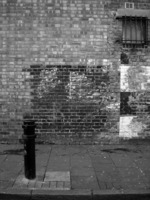Flemish Bond
Sara De Bondt-
-

- Sara De Bondt for the Architectural Association, 2008
-
Ugliness
Sometimes when I return to London on the train and look out of the window I think to myself how ugly the city is. I have been living here for six years now and yet I still don’t understand why this thought pops into my head. Where does it come from, what is it based on?
Alvar Aalto
Last year I went to see an exhibition on Alvar Aalto. In it there was a photograph of one of the most amazing buildings I have ever seen, his Muuratsalo Experimental Summer House (1952–53). Its walls are constructed using bricks laid in loads of different patterns. I have been looking at bricks ever since.
Building a beginning
The first thing my parents did when they moved into the house I grew up in was to have all of the brickwork repointed. The mortar between bricks had turned into crumbling sand so that you could just push individual bricks through to the cavity behind. When Zak asked me to think of an inquiry for this exhibition, I started with architecture’s details, just as I would first begin the design of a book by looking at typefaces.
Flemish in London
I discovered a beautiful thing; that about 50 per cent of the brick buildings on my walk from home to the studio are made using a technique called ‘Flemish Bond’ – a way of bricklaying in which individual bricks are laid alternately width and lengthwise, so that you get a .—.—.—.—.— pattern. Flemish refugees imported it into England in the fifteenth century. This bond has always been seen as the most decorative, but it also has a functional logic to it – by alternating between brick width and length a double-thick wall is created, providing better support and insulation.
Possessions
Someone once pointed out a black crosshatch brick pattern in Cheshire to me. The pattern signified that the Duke of Westminster owns or once owned the specific building. This type are also called ‘Grey Diamonds’. I spotted one this weekend in London.
Bond not De Bondt
A bond is a way of laying bricks. There are a number of different types, the most common being English Bond, Flemish Bond, Herringbone Bond, Running Bond, English Cross Bond, Stack Bond and Common Bond.
‘Colour in the Town’ by Amédée Ozenfant
‘Stone is rare in London, but you have splendid bricks, a whole range of deep reds, of oranges and yellows, even of browns, greens and blacks. English bricks have a texture which modulates light exquisitely on days when it is sufficiently strong; brick is a treat to the eye when the sun shines and is strong enough to show the delicate variations of tints; but great masses of brickwork are horribly depressing during the gloomy days which are frequent in Great Britain.’ (William Braham, Modern Color/Modern Architecture, Ashgate Publishing, p.117.)







